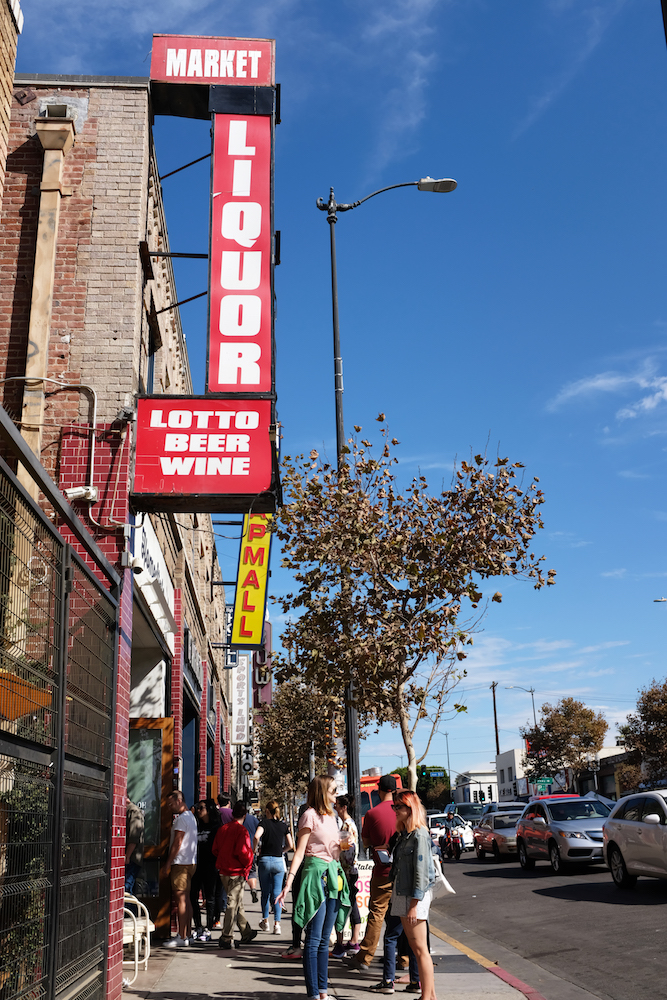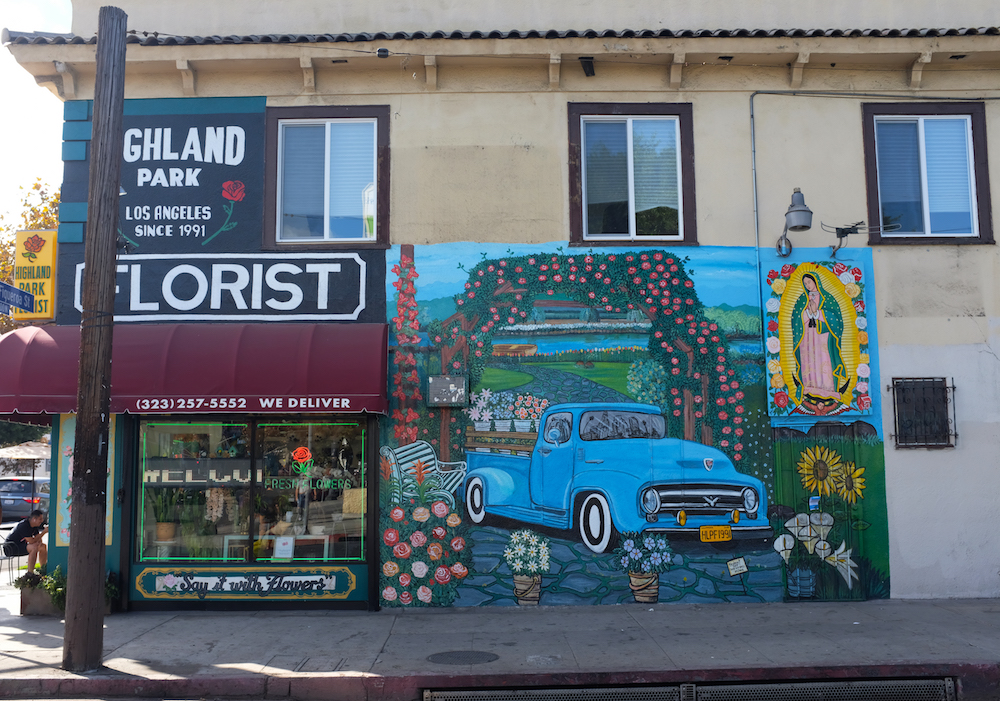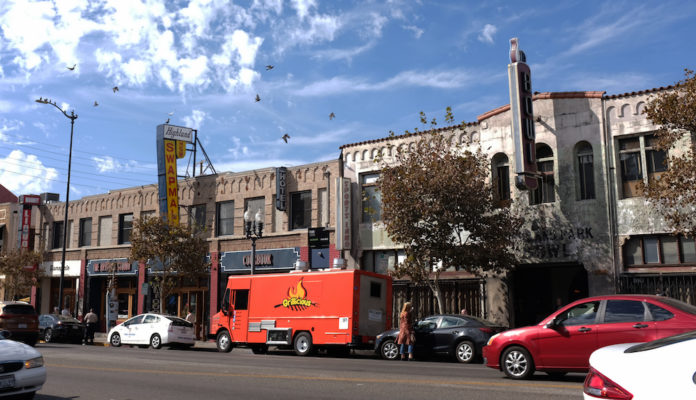Despite opening its glass doors and marble counters to Highland Park in 2012, Civil Coffee claims to know what Figueroa Street tastes like. They’ve channeled it into their specialty drink “The Figueroa”: milk (with dairy-free options), sweetened condensed milk, espresso and cinnamon topped with a Maria cookie.
For only $5, you get a Maria cookie loved by people around the world, especially in Latin America; oat-hemp milk hipsters swear by; and that iced coffee millenials drink like water. Latinx people make up 72.4 percent of Highland Park’s population, and the median age for the neighborhood is 28.
It’s spot on.
Figueroa runs north to south across Los Angeles for over 20 miles. The street is named after a former governor of Alta California, José Figueroa. Alta California was the name of the Mexican territory before California became a U.S. state. As Figueroa meandered through the city, it picked up bits of history along the way. North Avenue 56 intersects Figueroa under the shadow of the three-story brick Highland Park Masonic Temple. Masonic symbols, like the burning star and the square and compass, are carved into the white stone roofline echoing the intricate friezes of Greek and Roman buildings. Today, it houses one of LA Councilman Gilbert Cedillo’s offices. To find the history of Figueroa, look up.
The Highland Theatre sign is Figueroa’s version of the Hollywood sign. The Highland Theatre itself has lost its cinematic glamor since it opened in 1925. Its once regal maroon and ochre striped canopies have faded under layers of dust. The Theatre is in its autumn, clinging on before winter sweeps all of its color away. Just getting off from school, a group of high school boys debate which movie they’ll see. Before 6 p.m., matinees are only $7. They crowd onto the wide sidewalk unbothered by the smell of processed butter popcorn and nail polish from the salon next door. One boy walks over to the ticket counter, cash in hand. The Theatre holds on for another season.
Across the street, the sidewalk narrows. A line pours out of HomeState, a popular Texas kitchen serving breakfast tacos all day. Walkers weave around people scrolling on their phones waiting for their reservation as country music trickles out. No one bops along. Outside of Quiet Life, a men’s clothing shop specializing in trendy graphic T-shirts, miniature blue and red bean bags are neatly stacked on a wooden board with a hole in it, tempting you to stay and play a while.

In 2015, the Los Angeles Times predicted this area would become “one of the most caffeinated ones in the city.” People take advantage of all the smooth benches outside the many shops and sip their iced coffee. There are no empty seats.
A woman struggles with a parking meter, peering over it in her blush pink mules. Her long camel wool coat and wide-brimmed black hat seem too hot for the day’s weather. Fashion trumps practicality. For Saturday brunch, people dress in their best Kardashian neutrals — tans, pinks, grays and browns. With all of the glass windows and outdoor seating, everyone knows they’ll be seen from the street.
Figueroa values its Bs: brunch, barbershops and beauty salons in a repeating pattern down the street. From North Avenue 56 to 59, there are nine different places to have your hair cut, ranging from the no-frills to the all-frills. On the Marmion Way side of Figueroa, a barbershop is never just a barbershop. A woman wearing a baseball cap walks into The Artform Studio — she could be getting her styled, buying a record, or both. Hidden behind the white tile and marble of The Blind Barber is a full-service bar and cocktail lounge.
Danielle Noe, owner of Highland Park’s local apothecary Wild Terra, has lived in the neighborhood for the past seven years. She paused when describing the herbs and spices in her shop to look out the window.
“Did you know they’re opening up another barbershop down the street?” Noe said.
Figueroa’s other favorite B is bowling. Amid the sparkling and Instagram-worthy coffee shops, Highland Park Bowl is decrepit. The sickly gray paint peels away from the outside like a sunburn; it’s seen sunnier days. Inside, the alley’s new owners, the 1993 Group, restored it to its former Prohibition-era glory in 2016. During Prohibition, customers would receive a legal doctor’s note for whiskey on the pharmacy on the second floor, then head down to get their prescription filled at the bar. Outside of the alley’s bronze gates is The 1993 Group’s “Certificate of Recognition from the City of Los Angeles” for the preservation and restoration of this historic landmark.
The shops along Figueroa feel like they are curated into a seamless mix of old and new. Julie Wouellet, owner of the vintage clothing shop Charlie Roquette, said she travels “a little bit of everywhere” thrifting items for her curated shop. When looking for clothing items, she pays attention to textiles and textures: velvets, satins, leather, metallics and furs. Her dog Marlo runs around the shop modeling a navy silk scarf around his neck. She points to her favorite piece hanging on the wall: a black velvet and chiffon Oscar de la Renta dress.
The Oscar de la Renta dress of Figueroa is the Chicken Boy statue. His 22 feet of fiberglass feather and muscle has stood guard over the street from his perch above the Future Studio Gallery since 2007. The steadfast and reliable Virgo (his birthday is Sept. 1) looks down upon the neighborhood with fondness in his eyes. He grips his yellow bucket gently, but his shoulders are tense — don’t mess with his street.
Figueroa’s charm is not a secret. The wide street is framed with rows of gold-leafed trees the color of aging Golden Globe awards. Wrought-iron lamp posts pose tall like actors standing still for their close up. Coupled with the wealth of well-preserved Los Angeles-style architecture, Figueroa is a Hollywood filming playground. In 2012, the film “Gangster Squad” transformed the downtown Highland Park strip into 1940s Los Angeles.

Olie Lazaro has run Nature’s Perfection Flower and Gifts for the past nine years. He loves the neighborhood, but “the problem is when they come to film movies. We don’t have parking, so they take on the street and in the back for my customers.” Lazaro said the last time he saw film crews on the street was Nov. 7.
Like Hollywood, Lazaro is in the business of making places look beautiful. His small shop is lush with a jungle of greenery from large, leafy ferns to tiny succulents. The saxophone of George Michael’s “Careless Whisper” serenades the plants and they sway gently under the fans, albeit off-beat. Lazaro estimates that his shop provides plants for around 40 percent of the businesses along this strip of Figueroa.
One of his customers is Kitchen Mouse. The cafe is a plant-lover’s dream in quirky eggshell green and warm pink. The menu is primarily vegan and vegetarian. Lazaro’s plants hang from baskets along the high ceilings, and hand-painted pots with autumn flowers rest on the tables. Hidden mice are painted on the shop’s exterior. (There are six.)
Highland Park resident Holly Jackson sits outside with her dog Charlie and waits for her food. Jackson moved to the area from Hollywood. She said living in Highland Park doesn’t feel like she’s in LA.
“For the first time in LA, I feel like I’m in a neighborhood. I can walk to places and everyone is really friendly,” Jackson said.
Shopkeepers have rapport with each other. Noe often stops by Kitchen Mouse for lunch, or she said bartenders from Otoño would come into her apothecary looking for herbs to use in their specialty cocktails. Her shop carries herbs and spices from Peru to China, from the common cinnamon to the obscure vervain.
Many of the clothing stores try to cater to what the neighborhood wants. Erik Velasquez works at Mainline Skate Shop. An “everything must go” sign hangs outside. The skate shop added a vintage clothing line after seeing many vintage shops pop up along Figueroa. Amid the rising rent costs, Velasquez said the store is struggling to keep afloat and will close at the end of the year. He, and many of the customers, care more about the skateboards than the clothes, he said.
Fashion 21, the original Forever 21, seems to forget that the company filed for bankruptcy and is fading away. Older women and teenage girls browse the sales rack as Katy Perry’s “Never Really Over” booms overhead. The mannequins’ auburn lobs are reminiscent of the women at Civil Coffee, HomeState and Kitchen Mouse. The two teenage girls don’t look at the mannequins or the photos of models on the wall as they turn out of the store.
With their bright yellow Forever 21 bags, they pass better role models on the street. On the electrical boxes along Figueroa, artist Victoria J. Cruz has painted inspiring figures: Martin Luther King Jr., Maya Angelou, Muhammad Ali and Frida Kahlo.
On the corner of Figueroa and North Avenue 56, King’s quote on the box reads, “if you can’t fly then run, if you can’t run then walk, if you can’t walk then crawl, but whatever you do you have to keep moving forward.”
As the sun sets on Figueroa, the lamp posts slowly begin to glow, lighting the path forward.
![]()



































